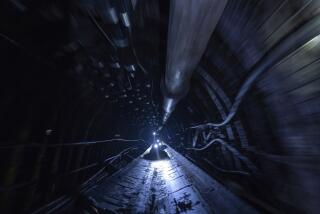Coal Mines Down Below Fuel Town’s Prosperity but Threaten Its Future
JHARIA, India — This city in eastern India bustles because of the coal underfoot.
People flock here for jobs in the mines burrowing beneath the city. Shops and restaurants are packed with customers. Buses, cars, trucks, bicycles and rickshaws jam the narrow streets.
Now, the city’s livelihood is threatening it too.
For Jharia’s 450,000 people, the sinkhole that suddenly opened a year ago and damaged more than 150 houses was the first tangible sign that warnings about the danger of undermining were real--not just a matter of government reports and bureaucratic debates.
“I heard an explosion and felt the earth splitting. Thousands of people ran from their homes in panic,” Rajendra Prasad, a local trader, recalled of that frightening day last October.
No one was killed, but Prasad said youngsters at a mosque school had a narrow escape.
Jharia, 810 miles east of New Delhi in India’s main coal region, sits atop about 300 million tons of coal worth $4.8 billion.
The city “is one of the costliest pieces of land in the world,” said T.N. Singh, deputy director of the government’s Central Mining Research Institute.
Coal is India’s primary energy source, fueling its factories and electricity production, and government leaders are intent on exploiting the coal fully to build the economy of one of the world’s poorest nations.
The people of Jharia accuse state-owned Bharat Coking Coal Ltd. of being blind in its pursuit of coal, digging out the city’s foundation with little thought for the safety of those living above the mines.
Bharat managers say the area under Jharia was hollowed out by private miners long before the state took over in 1972.
Canadian experts who completed a World Bank-financed study of the problem a few months before the sinkhole appeared concluded that the only answer was to move Jharia.
Collapsing tunnels are not the only threat. An underground coal fire has been burning for 80 years and towers of flames sometimes break through the surface. The town’s eight gasoline stations add to the risk, but so far the fire has not gotten out of control on the surface.
Last year, the coal company and municipal officials announced that they would tear down at least 22,000 houses. The cash-strapped company offered no compensation or help with relocation to the 110,000 people affected.
Authorities put up posters and distributed pamphlets warning residents of “the possible danger to their lives and property.” Outraged townspeople took to the streets in protest.
“The BCCL is creating a scare with a view to forcing people to leave the town. It can then mine the huge coal reserves” unhindered, said Gopal Aggarwal, a movie theater owner whose grandfather settled in Jharia in the 1920s.
The protests prompted the government to order a new study by the Central Mining Research Institute. In June, the government experts advised against mass evacuation, saying that only about 2,500 people needed to move and Jharia could be shored up by filling old mine tunnels with sand and other materials.
Contractors in the past were paid to fill the areas from which coal had been extracted, but the gaping holes that researchers have found indicate that the money was taken with no work done.
The mining institute said the fire could be controlled in part by digging out burning coal. A major firefighting operation begun in the 1980s by the coal company reduced the fire area from 6 3/4 square miles to 3 1/4 square miles.
Townspeople embraced the new assessment. But it appears they were persuaded less by facts and figures than by their own determination not to be moved.
“We have invested our life savings here. Where else do we go? Our property has become worthless,” said Gopal Singh, a shop owner. “Even if the government offers compensation to leave the town, it just won’t be enough to start our lives afresh elsewhere.”
It is unclear how much the mining institute’s plan would cost. And the coal company says it will need help from the federal and state governments to save Jharia.
The company’s losses already exceed its net worth by $47 million, said Bharat spokesman R. Prasad. The state-owned company is plagued by the inefficiency and mismanagement still common in India despite efforts to overhaul the economy along market lines.
(BEGIN TEXT OF INFOBOX / INFOGRAPHIC)
BACKGROUND
Coal powers electricity plants, steel mills and heavy industry in India, which has few other energy resources. But determination to exploit coal to the fullest and fuel economic growth in one of the poorest countries in the world often means that vulnerable people get hurt.
Associated Press journalists who recently visited India’s coal heartland--the northeastern state of Bihar--report on the problems in two stories:
* In Turi Tola and other nearby villages, tribal people who left their traditional homes in the mid-1980s to make way for a mine are being pressed to move again.
* In Jharia, people fear the city of 450,000 people is being endangered by indiscriminate mining that is honeycombing the land beneath them.
More to Read
Sign up for Essential California
The most important California stories and recommendations in your inbox every morning.
You may occasionally receive promotional content from the Los Angeles Times.









